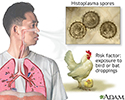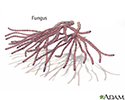Histoplasmosis - acute (primary) pulmonary
Acute pulmonary histoplasmosis is a respiratory infection that is caused by inhaling the spores of the fungus Histoplasma capsulatum.
Spores
A spore is a cell that certain fungi, plants (moss, ferns), and bacteria produce. Certain bacteria make spores as a way to defend themselves. Spores...
Read Article Now Book Mark ArticleCauses
Histoplasma capsulatum is the name of the fungus that causes histoplasmosis. It is found in the central and eastern United States, eastern Canada, Mexico, Central America, South America, Africa, and Southeast Asia. It is commonly found in the soil in river valleys. It gets into the soil mostly from bird and bat droppings.
You can get sick when you breathe in spores that the fungus produces. Every year, thousands of people with a normal immune system worldwide are infected, but most do not become seriously sick. Most have no symptoms or have only a mild flu-like illness and recover without any treatment.
Acute pulmonary histoplasmosis may happen as an epidemic, with many people in one region becoming sick at the same time. People with weakened immune systems (see Symptoms section below) are more likely to:
Acute
Acute means sudden. Acute symptoms appear, change, or worsen rapidly. It is the opposite of chronic.

Histoplasmosis
Histoplasmosis is an infection that occurs from breathing in the spores of the fungus Histoplasma capsulatum.

Weakened immune systems
Immunodeficiency disorders occur when the body's immune response is reduced or absent.

- Develop the disease if exposed to the fungus
- Have the disease come back
- Have more symptoms, and more serious symptoms, than others who get the disease
Risk factors include traveling to or living in the central or eastern United States near the Ohio and Mississippi river valleys and being exposed to the droppings of birds and bats. This threat is greatest after an old building is torn down and spores get into the air, or when exploring caves.
Symptoms
Most people with acute pulmonary histoplasmosis have no symptoms or only mild symptoms. The most common symptoms are:
-
Chest pain
Chest pain
Chest pain is discomfort or pain that you feel anywhere along the front of your body between your neck and upper abdomen.
 ImageRead Article Now Book Mark Article
ImageRead Article Now Book Mark Article -
Chills
Chills
Chills refers to feeling cold after being in a cold environment. The word can also refer to an episode of shivering along with paleness and feeling ...
 ImageRead Article Now Book Mark Article
ImageRead Article Now Book Mark Article -
Cough
Cough
Coughing is an important way to keep your throat and airways clear. But too much coughing may mean you have a disease or disorder. Some coughs are d...
 ImageRead Article Now Book Mark Article
ImageRead Article Now Book Mark Article -
Fever
Fever
Fever is the temporary increase in the body's temperature in response to a disease or illness. A child has a fever when the temperature is at or abov...
 ImageRead Article Now Book Mark Article
ImageRead Article Now Book Mark Article - Joint pain and stiffness
-
Muscle aches and stiffness
Muscle aches
Muscle aches and pains are common and can involve more than one muscle. Muscle pain also can involve ligaments, tendons, and fascia. Fascias are th...
 ImageRead Article Now Book Mark Article
ImageRead Article Now Book Mark Article -
Rash (usually small sores on the lower legs)
Rash
Rashes involve changes in the color, feeling or texture of your skin.
 ImageRead Article Now Book Mark Article
ImageRead Article Now Book Mark Article - Shortness of breath
Acute pulmonary histoplasmosis can be a serious illness in the very young, older people, and people with a weakened immune system, including those who:
- Have HIV/AIDS
HIV/AIDS
Human immunodeficiency virus (HIV) is the virus that causes acquired immunodeficiency syndrome (AIDS). When a person becomes infected with HIV, the ...
 ImageRead Article Now Book Mark Article
ImageRead Article Now Book Mark Article - Have had bone marrow or solid organ transplants
Bone marrow
A bone marrow transplant is a procedure to replace damaged or diseased bone marrow with healthy bone marrow stem cells. Bone marrow is the soft, fatt...
 ImageRead Article Now Book Mark Article
ImageRead Article Now Book Mark Article - Take medicines that suppress their immune system
Symptoms in these people may include:
- Inflammation around the heart (called pericarditis)
Pericarditis
Pericarditis is a condition in which the sac-like covering around the heart (pericardium) becomes inflamed.
 ImageRead Article Now Book Mark Article
ImageRead Article Now Book Mark Article - Serious lung infections
- Severe joint pain
Exams and Tests
To diagnose histoplasmosis, you must have the fungus or signs of the fungus in your body. Or your immune system must show that it is reacting to the fungus.
Tests include:
- Antibody tests for histoplasmosis
- Biopsy of infection site
-
Bronchoscopy (usually only done if symptoms are severe or you have an abnormal immune system)
Bronchoscopy
Bronchoscopy is a test to view the airways and diagnose lung disease. It may also be used during the treatment of some lung conditions.
 ImageRead Article Now Book Mark Article
ImageRead Article Now Book Mark Article -
Complete blood count (CBC) with differential
Complete blood count
A complete blood count (CBC) test measures the following:The number of white blood cells (WBC count)The number of red blood cells (RBC count)The numb...
 ImageRead Article Now Book Mark Article
ImageRead Article Now Book Mark Article -
Chest CT scan
Chest CT scan
A chest CT (computed tomography) scan is an imaging method that uses x-rays to create cross-sectional pictures of the chest and upper abdomen....
 ImageRead Article Now Book Mark Article
ImageRead Article Now Book Mark Article -
Chest x-ray (might show a lung infection or pneumonia)
Chest x-ray
A chest x-ray is an x-ray of the chest, lungs, heart, large arteries, ribs, and diaphragm.
 ImageRead Article Now Book Mark Article
ImageRead Article Now Book Mark Article -
Sputum culture (this test often does not show the fungus, even if you are infected)
Sputum culture
Routine sputum culture is a laboratory test that looks for germs that cause infection. Sputum is the material that comes up from air passages when y...
 ImageRead Article Now Book Mark Article
ImageRead Article Now Book Mark Article - Urine test for Histoplasma capsulatum antigen
Treatment
Most cases of histoplasmosis clear up without specific treatment. People are advised to rest and take medicine to control fever.
Your health care provider may prescribe medicine if you are sick for more than 4 weeks, have a weakened immune system, or are having breathing problems.
Outlook (Prognosis)
When histoplasmosis lung infection is severe or gets worse, the illness may last up to many months. Even then, it is rarely fatal.
The illness can get worse over time and become a long-term (chronic) lung infection (which doesn't go away).
Possible Complications
Histoplasmosis can spread to other organs through the bloodstream (dissemination). This is often seen in infants, young children, and people with a suppressed immune system.
When to Contact a Medical Professional
Contact your provider if:
- You have symptoms of histoplasmosis, especially if you have a weakened immune system or have recently been exposed to bird or bat droppings
- You are being treated for histoplasmosis and develop new symptoms
Prevention
Avoid contact with bird or bat droppings if you are in an area where the spore is common, especially if you have a weakened immune system.
References
Deepe GS. Histoplasma capsulatum (histoplasmosis). In: Bennett JE, Dolin R, Blaser MJ, eds. Mandell, Douglas, and Bennett's Principles and Practice of Infectious Diseases. 9th ed. Philadelphia, PA: Elsevier; 2020:chap 263.
Kauffman CA, Galgiani JN, Thompson GR. Endemic mycoses. In: Goldman L, Schafer AI, eds. Goldman-Cecil Medicine. 26th ed. Philadelphia, PA: Elsevier; 2020:chap 316.
-
Acute histoplasmosis - illustration
Histoplasmosis is a fungal infection caused by inhaling dust from spore-infected bird droppings. The acute form is treated with antifungal medication.
Acute histoplasmosis
illustration
-
Fungus - illustration
Fungal infections are caused by microscopic organisms (fungi) that can live on the skin. They can live on the dead tissues of the hair, nails, and outer skin layers.
Fungus
illustration
-
Acute histoplasmosis - illustration
Histoplasmosis is a fungal infection caused by inhaling dust from spore-infected bird droppings. The acute form is treated with antifungal medication.
Acute histoplasmosis
illustration
-
Fungus - illustration
Fungal infections are caused by microscopic organisms (fungi) that can live on the skin. They can live on the dead tissues of the hair, nails, and outer skin layers.
Fungus
illustration
Review Date: 3/10/2022
Reviewed By: Jatin M. Vyas, MD, PhD, Associate Professor in Medicine, Harvard Medical School; Associate in Medicine, Division of Infectious Disease, Department of Medicine, Massachusetts General Hospital, Boston, MA. Also reviewed by David Zieve, MD, MHA, Medical Director, Brenda Conaway, Editorial Director, and the A.D.A.M. Editorial team.





